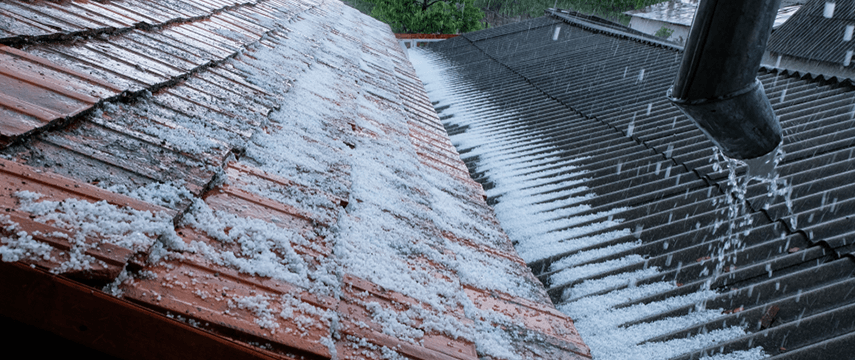Identifying signs of roof storm damage is easier when you know what to look for. Things like loose or missing shingles, chimney issues, granule weathering, and indoor leaks can indicate trouble.
We’re breaking down the most common types of roof storm damage, how to spot the warning signs, and how to prevent future damage to your roof. Follow these tips to catch storm damage early and save money in the long run.
So what are the most common causes of roof damage?
Causes of Roof Storm Damage
1. Wind
Wind damage usually results in shingle tears. These tears can result in water leakage into your home. Wind damage can be difficult to spot if you’re not up close, but you should never climb onto your roof to inspect shingles unless you are a roofing professional.
In most cases, wind damage becomes a risk when wind speeds reach 45 mph. 45 mph winds can cause minor damage like knocking shingles loose or bringing down dead tree branches. At 50 mph wind speeds, wind damage becomes even more of a concern.
2. Rain, Snow, and Water
It’s unlikely that rain or snow conditions on any given day will severely damage your roof, but over time they will wear away at your roof. Days of snow, for example, could wear your roof and cause expansion in shingles.
Monitor for moisture penetrating your roof, as this can lead to mold and mildew entering your home.
3. Hail
Hail damage usually results in craters or cavities in roofs. These cavities can lead to water damage if they are left untreated. Hail damage to your roof depends on wind speed and other factors like the size, shape, and density of the hail.
Certain roofs and roofing materials are more susceptible to hail denting. For instance, aluminum roofs tend to dent more easily. Siding damage, particularly vinyl siding damage, can also occur from hail cracking the vinyl.
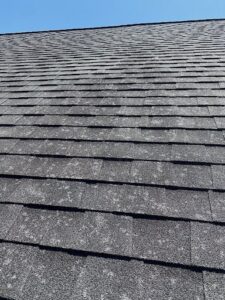
How to Spot Roof Storm Damage
The most important areas of your home to check after a storm are your roof, windows, gutters, and walls. Additionally, the type of roofing material your roof is made of will determine certain key indicators of storm damage. Let’s examine what to look out for based on your home’s roofing material.
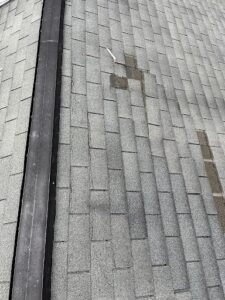
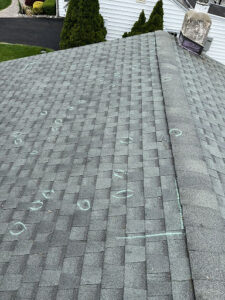
Asphalt Shingle Roofs
If your home has an asphalt shingle roof (as most U.S. homes do), look for loose, broken, or damaged shingles. If you see fallen shingles in your yard or notice unusual shingle patterns and discoloration on your roof, that indicates there could be roofing damage.
Replacing shingles immediately is key for preventing leaks and future structural damage to your home.
Cedar Shingle/Shake Roofs
Cedar roofs may require more attention than asphalt shingle roofs after a storm. Identify separated, broken, or cracked shingles/shakes. Damaged cedar shingles/shakes can lead to expensive leaks, so it’s best to replace them as soon as possible.
Metal Roofs
The good news is metal roofs are probably the easiest to spot damage to. Hail damage, for example, will cause visible dents.
Dents to metal roofs don’t necessarily mean you have to replace the roof. However, it’s still a good idea to have a professional come take a look if you’ve recently experienced a severe hail storm.
If there are openings in the metal that could cause leaks, separations between panels that let moisture in, or signs of rusting, then you may need to replace your metal roof.
EPDM Rubber (Flat Roofing)
EPDM rubber is waterproof, so it is generally more impervious to storm damage than other materials like asphalt and cedar. Flat roofs are also pretty easy to spot damage to, but usually not from the ground. Ask a storm damage roofer to inspect your flat roof if you have concerns.
Professionals should check for pools of water, tears in seams, or indentations in the roof. Flat roofs also don’t have self-draining inclines like other roofs, so a storm damage roofing company should check that your flat roof is draining properly.
Now that we’ve reviewed how to spot storm damage based on your roof type, let’s review some of the more general roof storm damage concerns you should be aware of.
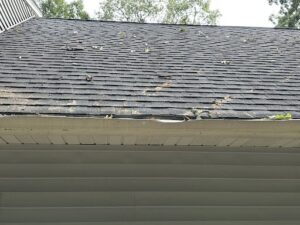
Other Common Types of Roof Storm Damage
1. Chimney, Skylight, and Vent Issues
Check your chimney, and in particular, the sealant around your chimney. Storms can shift chimneys and penetrate the sealant allowing moisture to get inside your home.
For chimneys and skylights, call professionals to check the sealed edges around chimneys and skylights to ensure moisture isn’t getting in. You should also check exhaust fans and vents for blockages, clogging, and proper airflow.
2. Gutter, Flashing, and Soffit Issues
Inspect these parts of your home next. Hail, winds, and heavy rains can loosen, crack, dent, and/or dislodge these vital weatherproofing components. From the ground, check for loose gutters, broken gutters, or gutters that are full of debris and draining poorly.
If your gutter isn’t transporting water efficiently, it can cause water to gather around your home’s foundation. Gutters that are filled with debris can also cause roof damage or leaks by allowing debris to build up on your roof.
3. Granule Weathering
Granule weathering occurs when shingle granules get worn away by severe weather. Why is this a problem? Shingle granules protect your roof from excessive sun exposure and add a layer of protective fire resistance.
Some granule loss over time is normal and to be expected. While age is the most common cause of granule loss, severe weather (heavy rain, hail, and high winds) accelerates granule weathering.
If you find an increased number of shingle granules in your gutter or on your lawn after a storm, that is a sign of premature granule loss.
To inspect granule loss, simply walk the perimeter of your home, and check your gutters and downspouts. Shingle granules most commonly run through your gutter system and end up in piles on the ground.
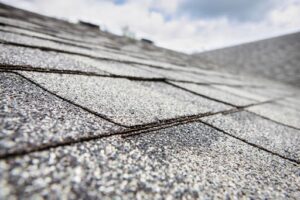
In some cases, you may be able to spot granule loss by looking at your roof from the ground. If you see bare spots or discoloration, you should get your roof inspected. Without granule protection, your home is at higher risk for sun and water damage.
Some granule loss is normal, so you don’t necessarily need to replace your roof if you notice it. The age of your roof and the severity of granule loss will dictate whether you need a complete storm damage roof replacement or just minor shingle repairs.
4. Indoor Leaks
Indoor leaks are sometimes overlooked as a key indicator of roof storm damage. Check for small pools of standing water and discoloration or dampness on walls, ceilings, or insulation. Damp conditions in your home can be dangerous, so it’s best to contact professionals if you discover indoor dampness or mold.
5. Tree Damage
If a tree falls on your roof and no one’s there to hear it, regardless of whether or not it makes a sound, you have a tree in your house. You definitely need to fix that.
More subtle tree damage can come from loose branches or debris getting thrown onto your roof due to high wind speeds. This kind of damage is still a concern because it can harm shingles and gutters. You’ll want to contact a storm damage roofer immediately if you suspect tree damage to your home.
How to Prevent Storm Damage
Inspect your roof regularly to stay ahead of the curve. A good roof inspection starts with the exterior. Examine your roof outside for any visible roof storm damage. This can be done from your lawn or driveway. You should not get on top of your roof to examine it unless you are a roofing professional.
From the ground, check for visible debris on top of your roof. In the case of obvious roof damage, such as a hole or tree in your roof, immediately contact a storm damage roofer.
After checking the exterior of your roof, you should also check the interior. If you have an attic, check that first. Look for leaks, cracks, or soft spots in your roof. Assess your walls for water damage or signs of animals, which could indicate holes in or along your roof.
If you don’t have an attic, check the ceilings of all the rooms in your home. Also examine walls, chimneys, skylights, and vents for evidence of leaks or other damages.
By being proactive, you can reduce your risk of major roof repairs caused by storms. Monitoring for roof storm damage can save you a lot of money by catching a problem in its early stages.
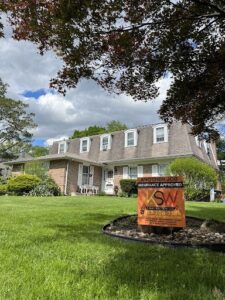
How KSW Construction Can Help You
KSW Construction proudly serves Central PA and can help you with all of your residential or commercial storm damage roof repair needs.
Check out some of our past roof replacement jobs in Central PA and see the difference that our craftsmanship makes in every job we do. What sets us apart? We complete a free, detailed inspection of your property to assess damages in our initial visit.
Then, we provide you with a record of all the damages, review them with you, and assist you with opening an insurance claim to restore your home to working order. From contract approval to installation, you can expect a 2-3 week turnaround for most roofing, siding, and gutter jobs.

